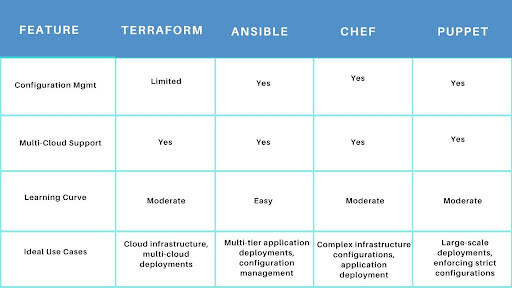Managing Infrastructure with Terraform and Other IaC Tools

This was a manual process in the past, riddled with potential for errors and inconsistencies due to its siloed nature. However, a game-changer has emerged in the form of Infrastructure as Code (IaC). This revolutionary approach allows for the automation and management of infrastructure using code. But what exactly are IaC tools, and how can they revolutionize your IT operations?
A. Decoding IaC: Infrastructure Made Easy
Imagine treating your infrastructure like software – defining its configuration and provisioning through code. This is the essence of IaC. IaC tools allow you to codify infrastructure resources (servers, networks, storage) as code files. These files describe the desired state of your infrastructure, enabling automated provisioning and management. This translates to several key benefits:
- Repeatability and Consistency: With IaC, you can bid farewell to the errors and inconsistencies that often plague manual configurations. By defining your infrastructure through code, you ensure your deployments are consistent across various environments.
- Enhanced Collaboration and Version Control: IaC configurations are stored in version control systems, allowing teams to collaborate effectively, track changes, and roll back deployments if necessary.
- Automation Efficiency: IaC automates infrastructure provisioning and management tasks, freeing IT staff from repetitive manual work and allowing them to focus on higher-level strategic initiatives.
B. The IaC Toolbelt: Your Allies in Infrastructure Automation
IaC tools serve as the bridge between infrastructure and code. These tools interpret your IaC code and interact with cloud providers or on-premises infrastructure to provision and manage resources. Here’s a glimpse into the world of IaC tools:
- Versatility Reigns Supreme: Popular IaC tools like Terraform offer a language-agnostic approach, allowing you to define infrastructure using a human-readable syntax.
- Cloud-Specific Solutions: Leading cloud providers like AWS offer IaC tools, such as AWS CloudFormation. These tools seamlessly integrate with their services, making it even easier to manage your infrastructure.
C. Why Embrace IaC Tools? The Power of Automation
The advantages of incorporating IaC tools into your IT infrastructure management strategy are undeniable:
Reduced Operational Costs: Automation streamlines processes, minimizes human error, and frees up IT resources, leading to significant cost savings.
Improved Infrastructure Agility: IaC empowers you to rapidly provision and scale infrastructure, inspiring accelerated development cycles and deployment timelines.
Enhanced Infrastructure Security: IaC tools enforce consistent security configurations across your infrastructure, significantly reducing the risk of security vulnerabilities and providing reassurance.
IaC tools are now futuristic but essential for managing complex infrastructure in today’s dynamic IT landscape. By embracing IaC, you can automate tedious tasks, relieving your IT team from repetitive manual work and empowering them to focus on innovation and strategic initiatives.

A Powerful Tool in the IaC Arsenal
Terraform reigns supreme among these tools, offering a robust and versatile approach to automating infrastructure provisioning and management. Let’s explore its key features and advantages.
A. Terraform: A Leader in the IaC Landscape
Terraform, created by HashiCorp, has become a widely adopted IaC tool due to its:
- Multi-Cloud Support: Terraform seamlessly interacts with many cloud providers (AWS, Azure, GCP, etc.) and on-premises infrastructure. This flexibility empowers you to manage infrastructure across diverse environments using a single tool.
- Declarative Configuration: Terraform utilizes a human-readable configuration language (HCL) to define your desired infrastructure state. This declarative approach focuses on “what” you want rather than “how” to achieve it, promoting readability and maintainability.
- Open-Source and Community-Driven: Terraform’s open-source nature fosters a vibrant community that continuously contributes to its development and offers a wealth of resources and support.
B. Unpacking the Powerhouse: Key Features of Terraform
Terraform boasts a rich set of features that streamline infrastructure management:
- Resource Management: Terraform enables you to define and manage various infrastructure resources, such as virtual machines, networks, databases, and more, all within a single configuration file.
- Providers and Modules: Providers act as plugins, allowing Terraform to interact with specific cloud platforms or infrastructure services. Modules promote code reusability by encapsulating infrastructure configurations for particular functionalities.
- State Management: Terraform tracks the state of your infrastructure (created resources) in a Terraform state file and ensures idempotence, guaranteeing that infrastructure is only provisioned or modified as defined in your configuration.
- Version Control Integration: Terraform configurations can seamlessly integrate with version control systems like Git. This facilitates collaboration, tracks changes, and enables rollback to previous infrastructure states if necessary.
C. Reaping the Benefits: Why Choose Terraform for IaC?
By incorporating Terraform into your infrastructure management strategy, you unlock a multitude of benefits:
- Enhanced Automation and Efficiency: Terraform automates repetitive infrastructure provisioning tasks, freeing your valuable time and resources.
- Improved Consistency and Reliability: Declarative configurations ensure consistent infrastructure deployments across environments, minimizing the risk of human errors.
- Simplified Collaboration and Version Control: Version control integration promotes collaboration and enables easy tracking of infrastructure changes.
- Reduced Infrastructure Drift: Terraform helps identify and address infrastructure drift, ensuring your infrastructure remains aligned with your desired state.

Exploring Other IaC Tools: A Multi-Tool Landscape
While Terraform reigns supreme in the IaC realm, it’s not the only contender. Let’s delve into the functionalities and strengths of some alternative IaC tools:
A. Overview of Alternative IaC Tools:
- Ansible: This open-source tool offers a robust, agent-based approach to infrastructure automation. It utilizes playbooks, reusable modules, and roles to manage configurations across diverse environments, making it a strong choice for multi-cloud deployments.
- Chef: A pioneer in the IaC arena, Chef leverages a server-centric architecture focusing on configuration management. “Recipes” define desired infrastructure states, ensuring consistency across your deployments. Chef excels in managing complex configurations for applications and infrastructure.
- Puppet: Like Chef, Puppet utilizes a client-server architecture and a declarative language (Puppet language) to define infrastructure configurations. Puppet excels in large-scale deployments and enforces strict configuration management for servers and applications.
B. Comparison of Features and Use Cases:

C. Considerations for Choosing the Right IaC Tool:
Selecting the perfect IaC tool hinges on your specific needs:
- Infrastructure Complexity: Terraform or Ansible might be ideal for intricate cloud infrastructure deployments.
- Configuration Management Needs: If configuration management is a priority, Chef or Puppet could be strong choices.
- Team Skills and Experience: Consider your team’s familiarity with different IaC languages and tools.
- Existing Infrastructure: If you’re heavily invested in a particular cloud platform, a native IaC tool like AWS CloudFormation might be a good fit.
Remember, the IaC landscape is constantly evolving. New tools and features emerge regularly. By understanding the core functionalities and strengths of various IaC solutions, you can make an informed decision that aligns perfectly with your infrastructure needs and empowers your team to manage your infrastructure efficiently and securely.
Best Practices for Mastering Infrastructure with IaC Tools
While IaC tools offer immense benefits for infrastructure management, mastering them effectively empowers IT professionals and developers, giving them the control they need. This mastery requires the following key best practices:
A. Infrastructure as Code Principles and Standards
Before diving into code, establish a set of IaC principles and standards within your organization. This collaborative effort ensures consistency, maintainability, and security across your infrastructure codebase, fostering a sense of shared responsibility.
- Define coding conventions: Establishing a consistent coding style for your IaC projects improves readability and collaboration among team members.
- Document everything: Documenting your infrastructure configurations within your IaC code makes it easier for others to understand and maintain the infrastructure.
- Prioritise security: In the world of IaC, security is paramount. Implementing security best practices within your IaC code, such as using least privilege and leveraging secure coding practices, instills a sense of caution and responsibility.
- Standardise resource naming: Maintain consistent naming conventions for your infrastructure resources to improve readability and reduce the risk of errors.
B. Modular and Reusable Infrastructure Components
IaC shines when you leverage modularity and reusability. Here’s how:
- One critical advantage of IaC is its ability to leverage modularity and reusability. Instead of dealing with monolithic code, break down your infrastructure configurations into smaller, reusable modules. This approach promotes code reuse, simplifies maintenance, and enhances the scalability of your infrastructure.
- Create reusable functions: Develop reusable functions within your IaC code to encapsulate everyday tasks, reduce es code duplication, and improve maintainability.
- Utilise variables and data sources: Define variables to hold configurable values and utilize data sources to retrieve infrastructure data dynamically and enable flexible and adaptable infrastructure configurations.
C. Ensuring Consistency and Automation: Version Control and CI/CD Pipelines
Treat your IaC code just like any other code. Here’s how to integrate IaC with your development workflow:
- Version control your IaC code: Store your IaC code in a version control system like Git and enable version tracking, collaboration, and rollback capabilities.
- Implement CI/CD pipelines: Integrate your IaC code with a CI/CD pipeline, allowing automated testing, deployment, and rollback of your infrastructure changes.
- Test your infrastructure code: Write unit and integration tests for your IaC code to ensure its functionality and catch errors early in development.

IaC in Action: Real-World Use Cases and Success Stories
The power of IaC tools extends far beyond theory. Organizations leverage these tools to streamline infrastructure management and unlock significant benefits. Let’s delve into real-world examples and success stories that showcase the transformative impact of IaC:
A. IaC in the Wild: Real-World Examples
- Cloud Migration Made Easy: Netflix, a leading online streaming service with over 220 million subscribers globally, utilized Terraform to automate the migration of its infrastructure to the Amazon Web Services (AWS) cloud platform.
This IaC approach ensured consistent configuration across all migrated resources, minimizing errors and expediting migration. A study found that organizations leveraging IaC tools experience an average 60% reduction in cloud migration time compared to manual methods. - Multi-Cloud Mastery: HSBC, a multinational financial institution in over 60 countries, adopted Ansible to manage its complex multi-cloud infrastructure.
Ansible’s flexibility and multi-cloud capabilities empowered them to automate infrastructure provisioning and configuration across various cloud providers, ensuring consistency and reducing manual effort. A survey indicates that 74% of organizations with multi-cloud environments have adopted IaC tools to manage their infrastructure. - AWS Expertise at Scale: Amazon, the e-commerce giant, utilizes AWS CloudFormation to manage its entire infrastructure on AWS. CloudFormation templates enable them to define and deploy their infrastructure resources in a codified and repeatable manner, streamlining deployments and facilitating infrastructure updates.
B. Lessons Learned: Success Stories and Beyond
These real-world examples highlight the key benefits of implementing IaC tools:
- Increased Efficiency and Agility: IaC automates repetitive tasks, allowing IT teams to focus on strategic initiatives and accelerate infrastructure deployments. A study revealed that organizations using IaC tools achieve an average 30% improvement in infrastructure provisioning speed.
- Improved Consistency and Reliability: Codified infrastructure configurations minimize errors and ensure consistent deployments across environments.
- Enhanced Collaboration and Version Control: IaC tools facilitate collaboration and version control, enabling teams to track changes and manage infrastructure configurations effectively.
Beyond the Success Stories:
It’s important to acknowledge that IaC adoption comes with its own set of considerations:
- Security Concerns: IaC code can introduce security vulnerabilities if not managed properly. Implementing robust security best practices is crucial.
- Vendor Lock-in: While some IaC tools offer multi-cloud support, others might tie you to a specific cloud provider. Evaluating your long-term infrastructure strategy is essential.

Conclusion
In summary, a new strategy is required due to the constantly increasing complexity of infrastructure management. IaC Tools, like Terraform and its allies, have become vital partners in this fight. IaC enables enterprises to attain previously unheard-of consistency, efficiency, and control levels by automating deployments and codifying infrastructure configurations.
Our exploration of success stories clearly shows how Infrastructure as a Code (IaC) simplifies infrastructure administration, lowers errors, and promotes teamwork. However, applying IaC while keeping security best practices in mind and being mindful of possible vendor lock-in is imperative.
As you embark on your IaC journey, remember that IaC Tools is a potent addition to your infrastructure management toolbox rather than a magic cure. IaC can be fully utilized, and the groundwork for a resilient, adaptable, and future-proof infrastructure can be laid by selecting the appropriate tool, comprehending its advantages, and implementing safe practices.
How can [x]cube LABS Help?
[x]cube LABS’s teams of product owners and experts have worked with global brands such as Panini, Mann+Hummel, tradeMONSTER, and others to deliver over 950 successful digital products, resulting in the creation of new digital revenue lines and entirely new businesses. With over 30 global product design and development awards, [x]cube LABS has established itself among global enterprises’ top digital transformation partners.
Why work with [x]cube LABS?
- Founder-led engineering teams:
Our co-founders and tech architects are deeply involved in projects and are unafraid to get their hands dirty.
- Deep technical leadership:
Our tech leaders have spent decades solving complex technical problems. Having them on your project is like instantly plugging into thousands of person-hours of real-life experience.
- Stringent induction and training:
We are obsessed with crafting top-quality products and hire only the best hands-on talent. We train them like Navy Seals to meet our standards of software craftsmanship.
- Next-gen processes and tools:
Eye on the puck. We constantly research and stay up-to-speed with the best technology has to offer.
- DevOps excellence:
Our CI/CD tools ensure strict quality checks to ensure the code in your project is top-notch.
Contact us to discuss your digital innovation plans, and our experts would be happy to schedule a free consultation.
![Blog-[x]cube LABS](https://d6fiz9tmzg8gn.cloudfront.net/wp-content/uploads/2016/06/blog_banner.jpg)






